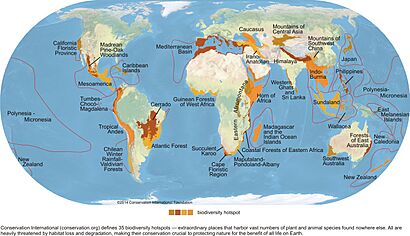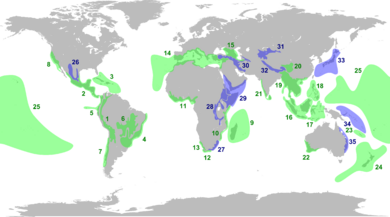Biodiversity hotspot facts for kids
Imagine places on Earth that are super special because they have tons of different plants and animals. These areas are called biodiversity hotspots. They are like natural treasures, but they are also in danger because of human activities.
The idea of biodiversity hotspots was first talked about by a scientist named Norman Myers in the late 1980s. He later worked with others to clearly define these areas in 2000. They wanted to highlight places that needed urgent help to protect their unique wildlife.
To be called a biodiversity hotspot, an area must meet two important rules:
- It must have at least 1,500 different kinds of vascular plants that are found nowhere else in the world. These are called endemic species.
- It must have lost at least 70% of its original natural land. This means a lot of its forests, grasslands, or other habitats have been destroyed.
Right now, there are 36 places around the world that fit this description. These hotspots are home to almost 60% of all plant, bird, mammal, reptile, and amphibian species on Earth. Many of these species are endemic, meaning they live only in that specific hotspot. Some hotspots have lost as much as 95% of their natural habitat.
Biodiversity hotspots cover only a tiny part of the planet's surface, about 2.4%. Even though they are small, they are incredibly important for life on Earth. Many of these areas, like the Caribbean Islands, the Tropical Andes, and the Philippines, are losing their natural habitats very quickly. This loss of habitat puts many unique plants and animals at risk of disappearing forever.
Contents
Protecting Hotspots: What's Being Done?
Only a small part of these important biodiversity hotspots is currently protected. Many groups around the world are working hard to save these special places.
Global Conservation Efforts
- The Critical Ecosystem Partnership Fund (CEPF) gives money and help to groups working to protect the richest areas of plant and animal diversity. This includes biodiversity hotspots.
- The World Wide Fund for Nature (WWF) has a plan called "Global 200 Ecoregions." They pick important areas to protect based on how many different species they have and how unique they are. All biodiversity hotspots contain at least one of these Global 200 Ecoregions.
- Birdlife International finds "Endemic Bird Areas" (EBAs) where two or more bird species live that are found nowhere else. They have found over 11,000 Important Bird Areas globally.
- Plant life International helps find and manage "Important Plant Areas" to protect unique plant species.
- The Alliance for Zero Extinction is a group of scientists and conservation organizations. They work together to protect the most threatened species that live only in one place. They have found 595 such sites.
- The National Geographic Society has created maps and information about biodiversity hotspots. This information helps conservation groups like Conservation International plan their work.
- In India, the Compensatory Afforestation Management and Planning Authority (CAMPA) works to control the destruction of forests.
Where Are Hotspots Found?
Most biodiversity hotspots are found in tropical areas, which are warm regions near the Earth's equator. Some hotspots are in very old, stable places that have been isolated for a long time. These areas are called OCBILs (Old, Climatically-Buffered, Infertile Landscapes). They are special because they have very stable environments and can be home to many unique species that have evolved over millions of years. However, even these stable areas are now at risk due to human activities.
Here are some of the 36 biodiversity hotspots around the world:
North and Central America
- California Floristic Province
- Madrean pine–oak woodlands
- Mesoamerica
- North American Coastal Plain
The Caribbean
South America
- Atlantic Forest
- Cerrado
- Chilean Winter Rainfall-Valdivian Forests
- Tumbes–Chocó–Magdalena
- Tropical Andes
Europe and West Asia
- Mediterranean Basin
- Caucasus
- Irano-Anatolian
Africa
- Cape Floristic Region
- Coastal Forests of Eastern Africa
- Eastern Afromontane
- Guinean Forests of West Africa
- Horn of Africa
- Madagascar and the Indian Ocean Islands
- Maputaland-Pondoland-Albany
- Succulent Karoo
Central Asia
- Mountains of Central Asia
South Asia
- Eastern Himalaya
- Indo-Burma, Bangladesh, India and Myanmar
- Western Ghats and Sri Lanka
Southeast Asia and Asia-Pacific
- East Melanesian Islands
- New Caledonia
- New Zealand
- Philippines
- Polynesia-Micronesia
- Eastern Australian temperate forests
- Southwest Australia
- Sundaland, Indonesia and Nicobar islands of India
- Wallacea of Indonesia
East Asia
- Japan
- Mountains of Southwest China
See also
- Biodiversity
- Conservation biology
- Crisis ecoregion
- Ecoregion
- Global 200
- Hawaiian honeycreeper conservation
- High-Biodiversity Wilderness Area
- Hope spot: biodiversity hotspots in the open sea
- Key Biodiversity Area
- Megadiverse countries
- Protected area
- Wilderness
- Type locality hotspots



